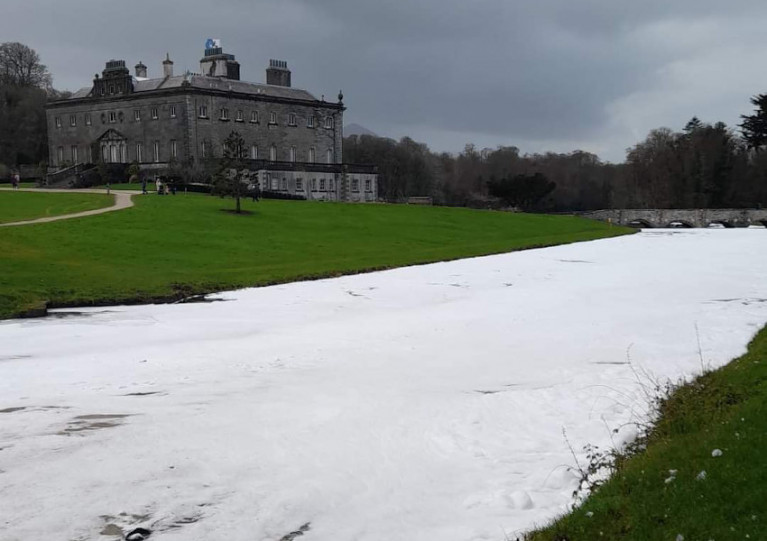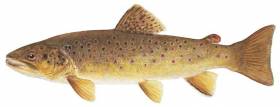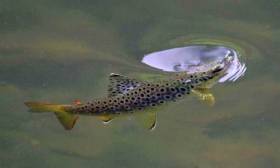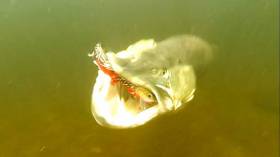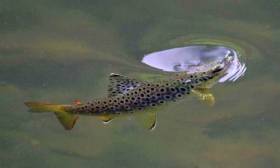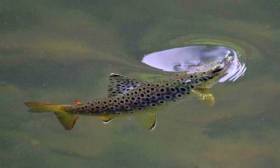Displaying items by tag: brown trout
Public Consultation on Reduction of Daily Bag Limit for Brown Trout in Galway District
Inland Fisheries Ireland (IFI) is seeking submissions in relation to a proposal to reduce the daily bag limit of four brown trout to two brown trout on the rivers Clare, Abbert, Dalgan, Grange and Sinking in the Galway Fishery District.
The current daily bag limit of four brown trout for these rivers is included in the Western Fisheries Region Conservation of Trout Bye-law no. 840, 2008.
Having reviewed the existing bye-law, IFI propose to put in place a separate new bye-law for the aforementioned rivers.
A copy of the existing and proposed new bye-law are available for public inspection at the IFI offices in Galway. The draft bye-law is also available on the IFI website.
The public consultation period will run for the next four weeks and the closing date for receipt of submissions is 5pm on Thursday 14 September.
Submissions should be marked “Public Consultation – Clare River brown trout bag limit” and be submitted by email to [email protected] or by post to:
The Director,
Inland Fisheries Ireland,
Teach Breac,
Earl’s Island,
Galway, H91 E2A2
Inland Fisheries Ireland (IFI) has appealed to landowners to consult with it before carrying out works on or near watercourses after a Longford man was fined or disturbance of spawning beds.
Colm Ginty from Dunbeggan, Aughnacliffe, Co Longford was convicted and fined €1,000 and ordered to pay a further €1,727.91 towards costs and expenses at Longford District Court on 12 April following a prosecution taken by IFI.
Judge Bernie Owens convicted Ginty under Section 173(1)(d) Fisheries (Consolidation) Act 1959 for carrying out works on the Aughnacliffe River on 30 June 2021 that involved the removal of a substantial amount of gravel from the channel of the river and causing the destabilisation of the bank.
These works were carried out in an area of spawning habitat for wild brown trout and disturbed and injured sensitive spawning beds and bank where the spawn or fry of trout may be.
The court heard evidence from senior fisheries environmental officer Ailish Keane as to the adverse impacts caused by the actions, which occurred along a 90-metre section of the river.
Keane also outlined the negative long-term impacts that the works would have on the lifecycle of the brown trout for years to come.
She explained that IFI staff frequently consult with farmers who want to carry out works in rivers and outline the way works should be carried out to avoid potential damage to fish life.
The Aughnacliffe River is a tributary of the Erne River Catchment which contains a prime spawning habitat for wild brown trout.
Milton Matthews, director of the North West River Basin District at IFI said: “Unauthorised and unplanned instream works put undue pressure on our native fish stocks through loss or degradation of fisheries habitat and spawning areas.
“It is a landowner's responsibility to get in contact with their agricultural advisor or Inland Fisheries Ireland before carrying out any works in or along on watercourses. Failure to do so may result in unnecessary and damaging impact to fisheries habitat and may be liable to prosecution.”
Fish Kill Confirmed on River Rye in Leixlip
Inland Fisheries Ireland (IFI) says it is investigating a serious fish kill incident at the River Rye in Leixlip, Co Kildare.
Environmental and fisheries officers from the Eastern River Basin District in Dublin were alerted to the incident on the evening of Wednesday 8 June.
Water and fish samples were taken from the scene and removed for scientific analysis at an independent laboratory.
IFI estimates that there could be in excess of 500 mortalities of brown trout plus other fish species in the impacted area covering approximately 2km of river.
Investigations are ongoing and IFI, the State agency responsible for the protection and conservation of freshwater fish and habitats, says it is not in a position to comment on the cause of the fish kill at this stage, pending further analysis of samples taken.
The River Rye (or Ryewater) is an important spawning river for brown trout and a key spawning channel for a highly sensitive population of Atlantic salmon within the River Liffey catchment area.
To report fish kills, members of the public are encouraged to call IFI’s confidential 24-hour hotline number on 0818 34 74 24.
It could be years before a river at the centre of a recent suspected agricultural pollution incident in Co Tyrone is fully recovered, as the Belfast Telegraph reports.
The fish kill in the Aughlish River discovered over the May Bank Holiday weekend covered a five-mile stretch of the Northern Ireland waterway between Dromore and Fintona, with reports of thousands of dead brown trout and young salmon to the Loughs Agency.
Omagh Anglers secretary Terry Smithson said the incident was “devastating”. He estimated that five years of salmon stock had been lost and it could be as many as three years before the waterway recovers.
The Belfast Telegraph has more on the story HERE.
Fisheries Officers Investigate Pollution Incident in Westport River Known for Brown Trout
Inland Fisheries Ireland (IFI) investigated a pollution incident that occurred last weekend on the Carrowbeg River in Westport, Co Mayo.
IFI received a number of calls to the hotline number and had a report from the landowner where the pollution incident occurred last Saturday 16 January.
Fisheries staff responded to the report of what’s understood to be an accidental detergent discharge into the Carrowbeg River that afternoon.
The Carrowbeg River is the main river that runs through Westport town and has an abundant indigenous brown trout population, as well as being is an important amenity to the local community.
IFI officers attended the scene and worked with the landowner to identify the source and to carry out immediate remedial works.
IFI says its staff continue to monitor the site and carried out kayak and drone surveys of the catchment area over the weekend to assess implications for the fishery. Surveys to date have not found any evidence of a fish kill resulting from the incident.
IFI says it has had “subsequent engagement with the landowner regarding remediation works to be undertaken at the site” and is liaising with with Mayo County Council’s Environmental Section on analysis of samples from the affected stretch of river.
Patrick Gorman, Galway director in the Western River Basin District at IFI, says: “Inland Fisheries Ireland urges members of the public to be aware of the environmental risk posed to their local waterbodies should such discharges be made into road or car park drain networks.
“Members of the public can report suspected pollution or poaching incidents to Inland Fisheries Ireland’s 24-hour confidential hotline on 1890 34 74 24.”
Wild Brown Trout Genome Sequencing Will Give Further Insight into "Superpower" Status, Queen's University Belfast Scientist Predicts
If there is one species to survive climate breakdown or transfer to a new planet, it is very likely to be the wild brown trout.
Humans may think they have “superpowers”, but the trout (Salmo Trutta) beats us all, according to Queen’s University Belfast (QUB) fish genetics expert Prof Paulo Prodöhl.
“Would wild brown trout survive life on another planet if there was water? I would put money on it,” Prof Prodöhl says, as he and fellow scientists celebrate the genome sequencing of the species.
The genome sequencing of wild brown trout was completed as part of a project to track the DNA of tens of thousands of lifeforms in Britain, led by scientists at the Cambridge-based Wellcome Sanger Institute and including QUB colleagues.
"Humans may think they have “superpowers”, but the trout beats us all"
The trout is one of “the most genetically diverse group of vertebrates”, with from three to 50 species currently recognised as such, the team explains.
The DNA sequencing will help to settle a longstanding debate about whether the physically varied fish is better recognised as a single species or several, Prof Prodöhl, who is attached to QUB’s Institute for Global Food Security, says.
This will enable conservation efforts targeted at specific populations during a period of rapid climatic change, he explains.
“The newly-sequenced DNA will also help to explain the mythical ‘”superpowers” of the iconic brown trout by facilitating the identification of unique genetic adaptations,” Prof Prodöhl adds.
These “superpowers” refer to its ability to survive every environment, and almost every environmental change, he says.
The species has form, as it was one of the first to recolonise previously frozen freshwater areas from the sea at the end of the last Ice Age.
“We know that brown trout has to undergo physical changes to move from freshwater to sea and then to come back to the same river to spawn,” Prof Prodöhl says.
“However, they are also quite remarkable in how they adapt to different environments, and we have research on Scottish trout which survived very high levels of acidity,” he says.
“You take the river Liffey and the most abused Dublin river, the Tolka, which were exposed to so much pollution – yet there are instances where trout were the only fish species that survived,” he says.
The trout’s “amazing genetic pool” proves once more that genetic diversity permits populations to respond to new challenges, he says.
The brown trout was one of 25 British species sequenced as part of the Sanger Institute project.
Grey and red squirrels, golden eagle and robins were also sequenced, and this has laid the groundwork for the Darwin Tree of Life programme which aims to sequence all 60,000 complex species in Britain.
The wild brown trout fishery generated some 148 million euro annually in angling tourism expenditure here, according to 2015 figures recorded by Inland Fisheries Ireland.
Public Consultation On New Bye-Law For River Bandon Trout
#Angling - Submissions are now open in a public consultation hosted by Inland Fisheries Ireland (IFI) around a proposed angling bye-law which focuses on the conservation of sea trout and brown trout on the River Bandon.
The new bye-law aims to help conserve the numbers of brown trout of all sizes taken from upstream areas of the river and its tributaries, as well as the numbers of young sea trout taken in the lower river and upper estuary.
There is currently no minimum length size specified when catching and retaining a sea trout or brown trout on the river. In addition, there is no ‘bag limit’ on the number of brown trout an angler can retain.
The new bye-law would set a minimum length of 25 centimetres for any sea trout or any brown trout caught and retained on the waters of the River Bandon and its tributaries, and a bag limit of not more than three brown trout per day on the waters of the River Bandon and its tributaries.
The bye-law would also require anglers to fish by catch-and-release methods, ban the use of worms, and allow only single barbless hooks in angling for brown trout once the three per-day bag limit had been reached.
Interested parties should make a submission to the consultation in writing. Submissions should be marked ‘Public consultation – River Bandon (Conservation of Trout)’ and be submitted by post to Inland Fisheries Ireland, Sunnyside House, Macroom, Co Cork, P12 X602 or by email to [email protected].
The deadline for receipt of submissions is 5pm on Monday 31 December. All submissions received by IFI will be published on its website at www.fisheriesireland.ie.
Trout Anglers Welcome New Bye-Law For Western Lakes - But Pike Angling Group Takes Aim At Minister
#Angling - The Connacht Angling Council has welcomed the new bye-law providing special protection for wild brown trout in the great western lakes.
As previously reported on Afloat.ie, the Designated Salmonid Waters Bye-law was signed last Thursday 25 October by the new Minister for Communications, Climate Action and Environment, Richard Bruton.
It means that Loughs Carra, Conn, Cullin and Mask in Mayo, Lough Corrib in Co Galway, Lough Arrow in Cos Sligo and Roscommon, and Lough Sheelin in Westmeath, Meath, Cavan and Longford will now be managed exclusively for the benefit of wild brown trout.
“We are delighted [former Environment] Minister Kyne took on board our grave concerns regarding the future of wild brown trout stocks in western lakes,” said Martin Kinneavy, chair of the Connacht Angling Council.
"There is now a sincere and genuine commitment to develop wild brown trout stocks in western lakes and a copper-fastened strategy to deal with the threat of predator pike.
“Our world famous Irish wild brown trout fisheries are now protected by law from pike and can reach their full trout angling potential.”
A previous bye-law in relation to the protection of pike in these waters will now no longer apply – which has raised the ire of pike anglers in the affected region.
Members of the Irish Pike Society are preparing a mass protest for the constituency offices of Minister Bruton and Taoiseach Leo Varadkar as well as Leinster House.
They argue that the bye-law changes “will decimate a section of the Irish angling industry which supports over 11,000 jobs and contributes almost €1bn to the Irish economy,” according to the society’s secretary Paul Byrne.
“The Irish Pike Society have over the past months engaged legal counsel and are fully prepared to challenge Minister Bruton in the High Court,” he added.
New Protections For Wild Brown Trout As Designated Salmonid Waters Bye-law Comes Into Operation
#Angling - The Designated Salmonid Waters Bye-law was yesterday (Thursday 25 October) signed by the Minister for Communications, Climate Action and Environment, Richard Bruton.
The overall intention behind the bye-law is to afford additional protection to wild brown trout in seven distinctive State–owned waters where established stock control measures are already in place as a matter of existing policy.
The seven waters are Lough Sheelin in the Limerick Fishery District; Loughs Conn and Cullin the Ballina Fishery District; Loughs Corrib, Mask and Carra in the Galway Fishery District; and Lough Arrow in the Sligo Fishery District.
Sean Canney, who is succeeding Sean Kyne as Minister of State with responsibility for the inland fisheries sector, welcomed the bye-law as an important initiative for brown trout fisheries particularly in the West of Ireland.
“My predecessor Seán Kyne gave notice of his proposals to make the bye-law and also instigated a public consultation during which observations and views expressed across the full range of stakeholders,” said Minister Canney.
“I am happy as incoming minister to support Minister Kyne’s long-standing initiative and his hard work over all of 2018 in bringing the bye-law to fruition.”
Minister Kyne said: “As minister with responsibility for inland fisheries, I had carefully considered the submissions made in the public consultation.
“The bye-law relates to seven limestone lakes which are quite unique in terms of topography and trout habitat and have long been managed as wild brown trout fisheries via established stock management programmes. From that perspective, I considered that these waters are especially important.
“The bye-law was just about complete when I was taking on my new role and I am grateful for the support of Ministers Bruton and Canney for bringing it over the line,” he added.
The bye-law gives statutory status to the policy designation of this small number of distinctive waters and means that the waters concerned will continue to be managed primarily as brown trout waters.
Minister Kyne had indicated his view that the importance of these waters should be reflected by way of statutory designation and commenced that process in the department.
The bye-law also includes the prohibition on the introduction of fish to the designated waters which is consistent with the overall policy thrust of Inland Fisheries Ireland to manage these waters primarily as brown trout waters.
The advantages of this measure include addressing biosecurity and genetic concerns, control and management of the potential transfer of pathogens, and safeguarding against the introduction of alien invasive fish species.
The announcement came as Bord Iascaigh Mhara is hosting a two-day conference on the scientific developments within the salmon farming industry in Galway’s Maldron Hotel on 25-26 of October.
Outlining the purpose of the event, BIM’s Geoffrey Robinson said: “With increasing global demand for fish, aquaculture is now the fastest-growing animal food production sector in the world. Consequently, fish farming operations are rapidly evolving with new technologies and equipment constantly being developed.
“Part of BIM’s work is to help fish farmers to keep their operations at the cutting edge of technology and an event like this allows us to showcase the latest innovations to Irish operators. There will be a number of interesting developments discussed not least the growing use of cleaner fish and desalination systems.”
Twenty-five separate presentations from national and international experts will cover the latest research and technological developments within the sector on issues such as fish health and welfare, structural and service equipment as well as organic certification.
“While production volumes in Ireland are small by international standards, we have a reputation for excellence in organic salmon production and it is important that our operations maintain this high standard. Incorporating leading edge technologies can improve our production efficiencies and strengthen our sustainable practices,” Mr Robinson added.
In 2017 Irish salmon production increased 15.6% to 19,305 tonnes, with a value of €141.2 million. The industry employs 210 people, primarily in production sites along the west coast of Ireland. Irish salmon is exported to diverse markets across the EU, North America and the Near and Far East.
#Angling - A new campaign is designed to alert anglers to renewed efforts to detect those who either take undersize trout or more trout than the rules allow.
Operation Ephemera is specifically focused on anglers fishing for trout during the annual hatch of the mayfly, and takes its name from its species name, Ephemera danica.
Mayfly season is traditionally the busiest time of year on Ireland’s prime wild brown trout limestone lakes, when fish are feeding on the surface and are ‘easier’ to catch.
The campaign will focus on Loughs Corrib, Mask, Carra, Conn, Cullen and Arrow, all in the west, and Loughs Sheelin, Owel, Ennell, Derravaragh and Ree in the Shannon catchment.
Anglers found flaunting the law will receive a fixed charge penalty notice, which attracts a fine of €150 which, if remaining unpaid after 30 days, will result in prosecution.
Compliance with other relevant angling regulations and rules, including relevant permit conditions which pertain on certain lakes, will also be enforced.
“Over recent years, we have been seeking the views of the angling public as to what they wanted IFI to do more of in terms of fisheries management in the coming years,” said Greg Forde, head of operations at Inland Fisheries Ireland.
“The theme that kept being repeated was that anglers wished to see more protection of the fisheries resource. Ultimately, there is a concern amongst anglers that not everyone on our lakes abide by the strict regulations that are in place to protect these extremely important wild brown trout and the mayfly period is when fish are most vulnerable.
“With Operation Ephemera, we are reminding anglers to familiarise themselves with the regulations pertaining to the lakes they are intending to fish and to abide by the law.
“We will also be highlighting the regulations and making leaflets available to anglers to help familiarise themselves with the rules.”
The campaign will be concentrated in May, but with hatches being late in some areas this year, this may extend into June.
It is appreciated that many anglers practice catch and release. But where trout are permitted to be retained, it is important that this is within the strict regulations for the respective lakes.
Anglers are also reminded that when fishing in a lake boat, all passengers must wear a buoyancy aid or lifejacket.



























